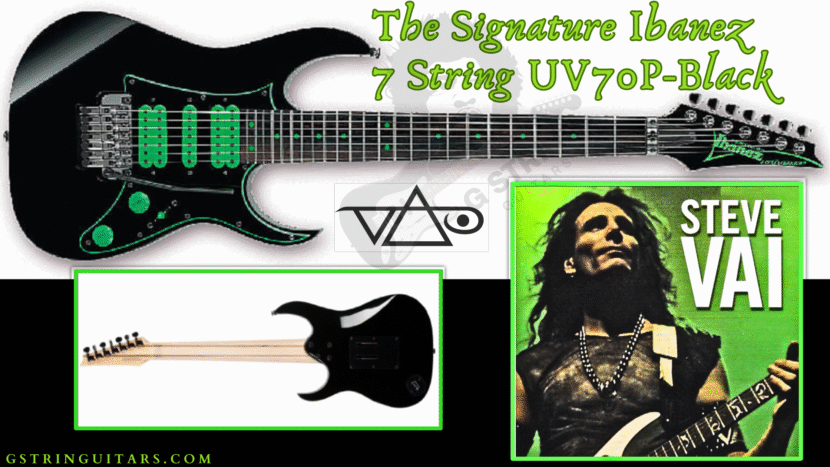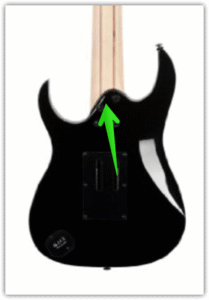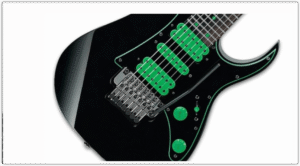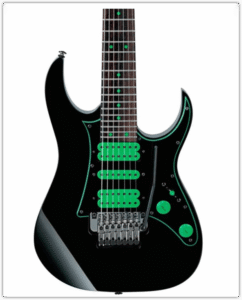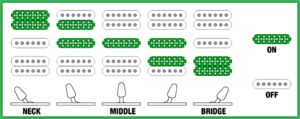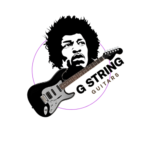The Ibanez UV70P-Black is a modern tribute to Steve Vai’s groundbreaking 7-string legacy.
Built for speed, tone, and expression, this guitar blends the iconic Universe DNA with accessible performance — perfect for players chasing Vai’s vision in a sleek, stage-ready form.
This Post May Contain Affiliate Links
In compliance with the FTC guidelines, please assume that some of the links on these posts and sites are affiliate links (Amazon or others) from which I may earn a small compensation/commission from sales of certain items at no extra cost to you from qualifying purchases.
Anytime you see a link that looks like “astore.com, paid link, #ad, #CommissionsEarned or Amazon/Amazon.com/ca,”… it can be assumed that it is an affiliate link.
To learn more, follow the link below.
The Ibanez Steve Vai 7 String-UV70P Black
When it comes to Rock Guitar, few names carry as much weight as Steve Vai.
Known for his virtuosic technique, stage presence, and genre-defying compositions, Vai has spent his career pushing musical boundaries. But beyond the notes and solos, the Artist’s influence can be seen in the very instruments he plays.
Enter the Ibanez Premium UV70P-Black, a modern reimagining of Vai’s groundbreaking original 7-string Universe Model.
Built for players who demand precision, Range, and expressive freedom, the UV70P offers the best of Vai’s vision at a more accessible price point than the original Prestige or Vintage models.
In this post, we’ll dive into the history behind the Vai-Ibanez partnership, the origin of the 7-string concept, how the modern version Signature Ibanez Steve Vai 7 string compares to earlier Universe models, and why this instrument deserves a serious look in today’s Guitar landscape.
A Quick Dive
More than just a shredder, Vai is an innovator, a gearhead, and a storyteller. His professional career launched at just 18 years old when he sent a transcription of Frank Zappa’s music to the legend himself.
Impressed, Zappa hired him as a transcriptionist and eventually as a guitarist in his band.
This was no easy gig; Zappa’s music was as demanding as it was unconventional.
Vai learned to navigate complex time signatures, experimental tones, and genre-blurring compositions, all of which would shape his unique musical voice.

Steve Vai in London 2001- Image Courtesy of Wikimedia – Author Erjon- and is licensed under the Creative Commons Attribution-Share Alike 3.0 Unported. The Image has been modified to highlight the Artist.
The ’80s Guitar Hero Era
In the mid-1980s, Vai stepped into the limelight by joining David Lee Roth’s band, following Eddie Van Halen’s departure.
His guitar work on albums like Eat ‘Em and Smile and Skyscraper combined flashy theatrics with deep musicality, showing the world that he wasn’t just fast — he was musically fearless.
Later, Vai joined Whitesnake for the 1989 ‘Slip of the Tongue” tour, further solidifying his status as a top-tier Guitarist in the rock and metal scenes.
Ibanez’s Vision
Building A Brand Through Signature Artists
In the late 70s and into the 80s, Ibanez was on the rise but not yet the global juggernaut it is today.
Ibanez Guitars – Image Courtesy of Wikipedia.org and is in the public domain.
Initially known for making affordable copies of popular American Guitars, the Brand began earning credibility for building high-quality instruments with serious performance potential. However, the company needed a way to stand out in a market dominated by giants like Fender and Gibson.
That spark came in the form of a visionary strategy.
Rather than making Guitars for the mass market, Ibanez would create bespoke instruments for elite and influential players, and use those Artist collaborations to build prestige and innovation into the Brand itself.
Why Signature Guitars Mattered
The idea was bold at the time.
Signature Guitars weren’t yet as standard as they are today, and few brands were taking the approach seriously.
Ibanez flipped that model on its head by:
-
Giving Artists creative control over design specs
-
Building Guitars that matched their playing style and personality
-
Leveraging the Artists’ fame to reach new and niche audiences
-
Reinventing the Electric Guitar with new shapes, colours, electronics, and playability features.
Rather than simply endorsing a product, Artists became co-creators.
The result?
Guitars that weren’t just good — they were tailor-made for the Artists who inspired them, becoming genuine personal expressions.
Steve Vai Was The Breakthrough

Steve Vai, May 2007- Image courtesy of Wikimedia Commons – Author RodrigoCD- and is licensed under the Creative Commons Attribution-Share Alike 3.0 Unported.
After years of playing modified Strats, Charvels, and Custom instruments, Vai realized that those Guitars weren’t quite cutting it for the explosive, theatrical, and expressive style of playing he was developing.
His personal needs suggested that he wanted a Guitar that was ergonomically comfortable, visually stunning on stage, tonally versatile, and engineered for high performance.
He approached the manufacturer with a set of radical ideas that needed architecture and vision.
Although most Guitar makers at the time would have passed on this, Ibanez saw potential.
The joint venture between the two brands marked a turning point, breaking new ground in form, function, and attitude.
Enter The JEM
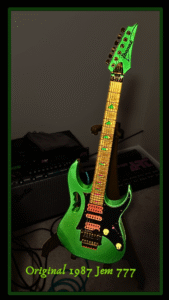
Image of the original 1987 Jem777 – courtesy of Wikimedia – Author Rrenzz – and is licensed under the Creative Commons Attribution-Share Alike 4.0 International license.
The Image was modified to highlight the Guitar.
The 1986-87 collaboration resulted in the Ibanez JEM777, which became the first model in what would become a legendary line.
It included ahead-of-its-time features such as:
-
The Monkey Grip: A literal handle cut into the body for style and utility.
-
Deep Lower Horn Cutaways: For full access to upper frets.
-
Fast Neck Profiles with Scalloped 21-24 Frets: For increased control and articulation on high notes.
-
High-Output DiMarzio Pickups: For screaming leads and chunky rhythm tones.
-
Floyd Rose-Style Floating Tremolo System: For aggressive dives, pitch manipulation, and more. (See Image)
The JEM became one of the most recognizable and popular signature Guitars ever made.
It wasn’t just the specs, the JEM screamed personality, and Vai’s playing backed it up.
From the neon finishes to the vine inlay and extreme sonic Range, it quickly became one of the most iconic Signature models in Guitar history, and the SuperStrat was born.
A SuperStrat is a Guitar design that builds on the Fender Stratocaster platform but with changes to enhance its playability.
These Guitar modifications typically included locking tremolo systems (often Floyd Rose), flatter-radius fingerboards, an aggressive-looking body with enhanced cutaways to facilitate access to the higher frets, a contoured heel at the neck joint, the use of humbucking pickups, and more. (See Image)
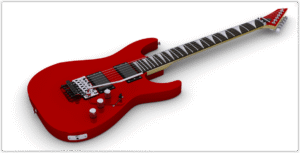
Superstrat based on ESP KH- Image courtesy of Wikimedia Commons- Author Spike78- is licensed under the CC BY-SA 4.0
Not Defined
Since there is no formal definition of a SuperStrat, categorization is still mainly left to popular opinion.
It depends significantly on the Artist (s) associated with a particular model and how it is marketed.
Road Tested
The JEM was no gimmick. It was a Guitar that delivered, both in the studio and on stage.
Vai used the JEM extensively during his tours with David Lee Roth and later with Whitesnake, where his wild stage persona and sonic wizardry were on full display.
These signature Guitars didn’t just look unique — they were highly functional tools and works of art for serious players, engineered from the ground up, and quickly became the poster child of the era.
Joint Venture Success
Ibanez capitalized on the momentum by offering several JEM iterations — including the FP (Floral Pattern), GMC (Green Multi-Colour), and the deeply desired JEM7V.
This instantly elevated the Ibanez brand and brought in a new wave of customers who were inspired by Vai’s style and the innovation behind his instruments, rewriting the rules of what a Signature Guitar could be.
This partnership is a shining example of how the right collaboration between an Artist and a company can lead to game-changing innovations that influence an entire generation of musicians.
Based on shared and mutual drive to push the limits of Guitar design, these relations between the two brands have now spanned over three decades.
With the Artist constantly seeking new ways to explore music, Ibanez has been there every step of the way to bring his ideas to life.
Why Ibanez Guitars Are Essential for Unique Musicians
Signature Series Explosion
Following the success with Vai’s JEM, the manufacturer doubled down.
The company began working with a roster of boundary-pushing Artists, many of whom were at the forefront of emerging genres including…
-
Joe Satriani (JS Series)
-
Paul Gilbert (PGM and FRM Series)
-
Korn’s Guitarists: James “Munky” Shaffer and Brian “Head” Welch (K7 7-string models)
-
Tosin Abasi (8-string pioneer, before launching his own Brand) and more.
Artist First
Each Signature Guitar helped carve out a new part of Ibanez’s identity and Brand as a company that was modern, technical, and Artist-driven.
It created instruments that weren’t just collectibles — they were workhorses for musicians, pushing boundaries, forward-thinking, and making an ecosystem of innovation by letting Artists lead the charge.
The famed Guitar company continues to thrive with this model, and it’s a reminder that when you put the Artist first, the product speaks louder than words can capture in a production-ready instrument.
New Territory
The success of the JEM laid the foundation for the partnership to make a bold move into extended-range territory, taking things one step further.
Vai’s willingness to experiment resulted in the Universe UV7 — and later, the UV70P-Black.
The Birth Of Vai’s Vision – The Electric 7-String
While 7-strings had been around prior, it was Vai who brought them roaring into the limelight with Ibanez’s game-changing Universe series.
While working on Frank Zappa’s projects in the 1980s, Vai began experimenting with different tunings, new sonic territory, and approaches to playing that pushed the boundaries of the traditional six-string.
The Need For More Sonic Low-End Range
Vai’s playing and music were known for their technical complexity and expressive freedom.
As he continued to experiment, he realized that the Sonic Range of a 6-string guitar was often limited to him.
In particular, he felt confined when trying to explore lower tunings and more complex chord structures.
One day, after working on a piece of music that required a deeper, more resonant low end, Vai had a breakthrough idea: what if he could add an additional string to his Guitar to give himself more low-end Range.
The Moment Of Inspiration
The idea for a 7-string crystallized during this period of experimentation.
He imagined a Guitar that extended his Range not upward, but downward, into a deeper sonic dimension and drew inspiration from extended-range instruments in other genres.
His goal was to achieve a lower register for heavier sounds and deeper chords, without losing the high-register sparkle, playability, familiarity, feel, and flexibility that a standard 6-string Electric provided.
Collaborating With Ibanez
With the new idea, they began working on the design and debuted the Universe (UV7) in 1991, resulting in the world’s first commercially available, mass-produced, revolutionary 7-string Electric Guitar. (See Image)

Ibanez UNIVERSE UV7 BK 1992 Green Dot 1992 Black MIJ Steve Vai fujigen 7 string- Image courtesy of Reverb.com
The instrument retained the agility and Shred-Ready capability of the JEM, and the famed Guitarist went on to use it on his live performances with Whitesnake, then extensively on his “Passion and Warfare“ album.
Some Of Its Features Included:
- A Similar Shape Basswood Body & Aesthetic To The JEM
- Made in Japan
- One-piece Maple Neck w/Rosewood Fretboard
- Three HSH DiMarzio Blaze pickups
- Lo-Pro Edge 7 Tremolo Bridge
- Unique 7-string Fast Neck Contour
The Legacy Of The 7-String
Not only did the introduction of the 7-string Guitar give the Artist a tool to express his creativity in ways he had never been able to before, but it also sparked a movement in the music world that became more mainstream, especially in genres like Progressive Rock, Alternative or Nu Metal.
Impact of the 7-String Guitars on Metal Music
It quickly became a cult classic among serious players, especially after bands like Korn and Dream Theatre adopted the 7-string format.
The Next Evolution
Fast-forward to 2013.
Ibanez decided to bring the Universe back to a broader audience as part of their Premium series, this time with a more accessible model, without compromising too much on tone or playability, and without the boutique-level price tag.
The UV70P Guitar
A Modern Universe for Today’s Player
While the UV70P lacks the “Prestige” of Japanese craftsmanship, it’s still a formidable player’s Guitar.
It’s not a reissue but a modern interpretation for today’s players.
It is part of their Premium series, which means it’s built to last and can perform under pressure, holding its own with rock-solid craftsmanship that can easily handle pro-level demands. (See Image)
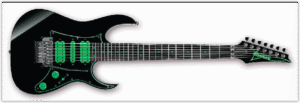
The UV70P SuperStrat features include a lightweight Basswood body, a Wizard 7 neck profile, premium fret edge treatment, and more.- Image courtesy of Amazon.com- Tap to see more.
Drenched in a sleek Gloss Black finish, with green dot inlays, this Guitar commands attention before you even plug it in.
Like its predecessor, every joint, cutaway, and contour has been purpose—built for speed, comfort, and control.
(Read on)
Tech Specs
Body
Final Thoughts

UV7OP – Image courtesy of Amazon.com
From G3 tours with fellow Guitar Virtuosos like Nuno Bettencourt to teaching masterclasses and releasing new music, Vai has never stopped evolving — and his signature Guitars reflect that journey.
They will continue to grow as he does.
Extra Fretboard Real Estate
I like the extra real estate of the fretboard because a lot of my practice is done on a nylon-string acoustic.
This helps me maintain my left-hand strength, and I find that this Guitar’s neck profile and fretboard radius allow for that feeling.
If you’re used to playing 6-string guitars, adapting to the wider neck and the extra low B string can feel awkward at first.
It demands a different approach to both rhythm and lead playing, and for some players, that adjustment can be more frustrating than inspiring.
Should You Add This to Your Collection?
That depends on what you’re looking for in an instrument.
This 7-string is far more versatile than it may appear at first glance.
Thanks to the extended Range, you get access to a whole new world of sonic possibilities — and it’s not just about low-end chug.
Jazz and fusion players who want to play basslines and melodies simultaneously love it for its harmonic depth.
At the same time, experimental progressive Guitarists use it to create ambient textures and counterpoint melodies.
If you want a Guitar that’s high-performance, gig-ready, road-tested, and reasonably priced, one that delivers both style and substance, the UV70P is a phenomenal option.
Did You Like This Article?
Want more Steve Vai?
Check out my Ibanez PIA review.
Also…
I would like to hear your comments in the section below. Please get in touch with me if you would like me to review a favourite guitar.
As always, stay the course and keep playing.

Starting A Journey At 7 Years Of Age, The Love For The Guitar Only Became Stronger Going Into My Teens. This Leading To An Exciting Time Of Teaching, Performing, And Recording. Join Me Now As We Can Bring The Love Of This Instrument To Other Musicians Globally.

